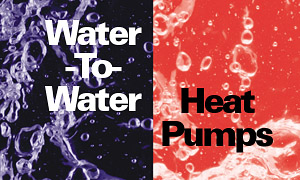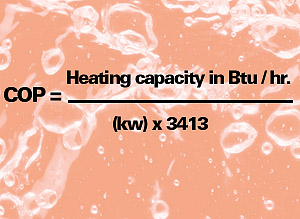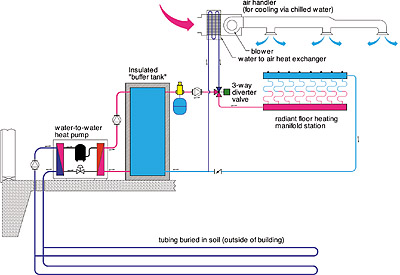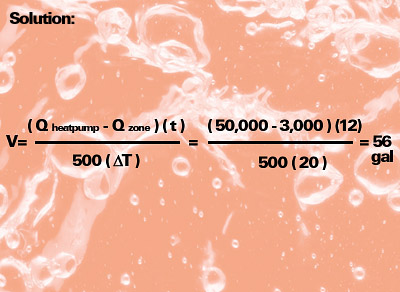
Heat pumps are used to move heat from one medium where it's readily available to another medium that can accept it. The medium donating the heat is called the "source," while the one receiving the heat is called the "sink."
Most heat pumps used in North America are more-specifically classified as air-to-air heat pumps. They absorb heat from outside air and release that heat into a forced-air distribution system within the building. The heat is moved using a standard vapor-compression refrigeration cycle. Cold liquid refrigerant is evaporated within the outside heat exchanger. The heat-laden refrigerant gas is then piped to the compressor that greatly increases both its pressure and temperature. The hot gas is routed inside to a refrigerant-to-air heat exchanger where it condenses back to a liquid giving up the heat it transported to the building's forced-air distribution system. The final step is to pass the cooled liquid through a thermal expansion valve that lowers its pressure and temperature, readying it for another trip to the outdoor unit.
By reversing the flow of refrigerant, air-source heat pumps can also operate as cooling systems. Heat absorbed from inside air is transported outside and rejected. The ability to function as both a heating and cooling system is without a doubt the biggest attraction of heat pump systems, especially in mid- to lower latitudes where cooling is a necessity.
Air-to-air heat pumps do have their limitations when it comes to space heating. The colder the outside air, the less heat each pound of refrigerant picks up as it circulates through the system. Heating capacity, as well as efficiency, decreases as outdoor temperatures fall. This inescapable constraint of thermodynamics often requires air-source heat pumps to be equipped with supplemental heat sources to handle peak loads in cold northern climates. If that supplemental heat is provided by electric resistance elements, the overall efficiency of the system can be reduced substantially. Air-to-air heat pumps also require a defrost cycle to remove frost from the outdoor heat exchanger during cold weather. Hot refrigerant gas is periodically recirculated in the outdoor coil to melt the frost. The energy used to defrost also lowers overall system efficiency.
Using Water Instead of Air
By using water-to-refrigerant heat exchangers (instead of air-to-refrigerant heat exchangers), it's possible to build a water-to-water heat pump. Such a device can extract heat from a flowing source of low temperature water and deliver that heat to another, higher temperature water stream. The low temperature source may be ground water, cooling water from an industrial process or even process water that needs to be chilled before use. Almost any situation where heat is available in the form of low temperature water, in combination with a simultaneous load to which heat can be delivered in the form of higher temperature water, is a possible application for a water-to-water heat pump.Over the last 10 to 15 years, there has been a considerable increase in the use of water-source heat pumps for space heating. Although the majority of such applications have used water-to-air heat pumps that deliver heat via a forced-air system, the increased use of low-temperature radiant floor heating has created an excellent opportunity for applying water-to-water heat pumps.
For space heating applications, water source heat pumps typically gather heat from the earth. Since soil temperature a few feet below the surface are considerably higher than the outside temperature during most of the winter, these "geothermal" systems enjoy a major performance advantage over their air-source counterparts.
During a cold January night in New England, the outside air temperature may be near zero, while the soil temperature six feet below the earth's surface is 45 to 50 F. The higher the temperature of the heat source, the higher the capacity and efficiency of any heat pump. Furthermore, unlike their air-source counterparts, geothermal heat pumps don't require defrosting, and when properly sized, seldom need supplemental heat.

Geothermal Sources
One method of gathering heat from the earth is to circulate water from a well, large pond or lake through a water-to-refrigerant heat exchanger within the heat pump. The temperature of ground water ranges from about 35¯ to 60¯F, depending on its source, geographic location and time of year. As the water flows through the heat pump its temperature drops 5¯ to 15¯F as heat is extracted. The water then returns to its source where it can absorb more heat. Because the water is not contained in a pressurized closed-loop, this approach is known as an "open-loop" geothermal heat pump system.Two factors are critically important to the success of any open-loop system. First, there must be a source of water near the building that can supply the heat pump while it's running. Most heat pumps require two to three gallons per minute of source water flow per ton (12,000 Btu/hr.) of heating capacity. A typical residential system demands between six and 12 gallons per minute of sustained water flow whenever it's operating. Over the course of a cold winter day, several thousand gallons of water pass through the heat pump. If the water source cannot keep up with this demand, the heat pump will eventually shut itself off due to low refrigerant suction pressure. This could leave the building without heat. Even worse, it can leave the building's occupants without domestic water (if the heat pump and domestic water come from the same source). Therefore, before committing to the installation of an open-loop geothermal system, be absolutely sure the source can supply the required quantity of water based on sustained design load flow requirements. Have a certified driller verify the sustained recovery rate of any drilled well being considered as a water source.
Secondly, the water supplied to the heat pump must be of sufficient quality. Water containing calcium carbonate, iron bacteria, hydrogen sulfide or other mineral/biological materials can eventually foul the water-to-refrigerant heat exchanger causing a water starvation condition and automatic shutdown. Cleaning the heat exchanger is messy, expensive and usually yields only a temporary reprieve from the problem. Any water source being considered should be thoroughly tested for mineral and biological content by a competent laboratory. Be sure the levels of any impurities are within the limits specified by the heat pump manufacturer.
Another method of extracting heat from the earth is to circulate water or a mixture of water and antifreeze through a closed piping loop buried several feet below grade. Heat is extracted by chilling the water circulating through the buried loop to a temperature lower than that of the surrounding soil. Heat migrates from the soil through the pipe wall and into the cooler fluid. The fluid carries the heat back to the heat pump, where it's again extracted by a standard refrigeration process. The chilled water flows back out into the buried loop to repeat the process.
The piping loop(s) begin and end at the heat pump. In combination with the heat pump's water-to-refrigerant heat exchanger, they form a closed loop piping system. Once filled with fluid and purged of air, nothing enters or leaves this closed-loop system. This approach all but eliminates the potential shortcomings of water quality and quantity associated with open-loop systems.
Ground loops are usually constructed of SDR-11 PE3408 high-density polyethylene pipe. All buried joints are heat fusion-welded using the same techniques employed to join polyethylene pipe for natural gas service. Mechanical coupling should never be used for buried joints since they can loosen over time due to thermal expansion and contraction. Some loops are buried in horizontal trenches, while others are inserted into one or more vertical bore holes. The amount of tubing required depends on location, soil type and how low the loop temperature will be allowed to drop. Consult the references at the end of the article for detailed design information.

Recycled Btus
Waste heat recovery in commercial or industrial buildings is another viable application for water-to-water heat pumps. Any process requiring chilled water has the potential to donate the unwanted heat to a simultaneous heating load in or near the same facility.In evaluating the feasibility of such a process, it's important to consider the timing of the cooling load, the rate of cooling necessary and what simultaneous heat load(s) are available to accept the heat. For example, a cooling load of 30,000 Btu/hr. could be readily dumped into the floor heating system of a large commercial building during most of the heating season. Dumping heat into a preheating tank for process hot water might be another option. However, an alternate heat sink, such as a cooling tower, may be required if neither space heating nor water heating loads are present at certain times of the day or year.
Adding an insulated storage tank to the system can help accommodate moderate differences between the heating and cooling loads. However, the operating temperature range of such a tank is limited by the fact that most water-to-water heat pumps using R-22 refrigerant can't heat water above 130¯F without tripping their high-pressure safety switches. Even if the heated water was usable down to, say, 95¯F (i.e. in a slab-type floor heating system), the working range of the tank is a mere 35¯F. Storing large quantities of heat using such a narrow temperature range necessitates large volumes of water, the economics of which are often unfavorable.

Watch Those Temperatures
Unlike conventional boilers, the heat output of a hydronic heat pump is very dependent on the temperature of its source water as well as its load water. The following two principles apply in all cases:
- The warmer the source water, the higher the heat output and efficiency of the heat pump.
- The lower the temperature of the hydronic load, the higher the heat output and efficiency of the heat pump.
The variations in capacity and efficiency can be significant. A water-to-water heat pump with a given heating capacity under favorable water temperatures can have less than half this capacity under more demanding conditions.
Selection of a water-to-water heat pump must be based on the source and load temperatures that occur at design load conditions on a particular project. Such conditions can be very different from the standard ARI (Air Conditioning and Refrigeration Institute) rating conditions listed in manufacturers' literature.
The graph in Figure 2 shows the variation in heat output of a typical small hydronic heat pump over a range of water temperature conditions. The normalized output of 1.0 is based on an entering source water temperature of 40¯F and entering load water temperature of 100¯F. Use the multipliers on the vertical axis to adjust the reference output for other water temperatures.
Heat pumps always produce more heat output than the electrical energy required to operate them. The ratio of a heat pump's heating capacity to the electrical energy required to run it is called its coefficient of performance, or COP. It can be calculated using Formula 1, where kw = the electrical input to the heat pump (in kilowatts).
The higher the COP of a heat pump, the greater the percentage of "free" heat in its total output. Water-to-water heat pumps connected to geothermal sources and low temperature (95¯-120¯F) loads typically have COPs in the range of 2.5 to 3.2. Technology improvements continue to produce incremental gains in COP.

Watch Those Flow Rates
Water-to-water heat pumps require constant water flow through both the evaporator and condenser while operating. If either flow stream is restricted, the heat pump quickly shuts itself off due to refrigerant pressure limits. Flow starvation can occur when the heat pump serves a zoned hydronic distribution system. Imagine a system in which one of several small zones calls for heat, and in so doing turns on a 50,000 Btu/hr. heat pump. All other zones remain off. System water temperature climbs quickly because the heat pump is adding heat to the system water much faster than the zone load is removing it. If system water temperature is regulated by a high limit control, the heat pump will be turned off after only a few minutes operation. Short-cycling will persist, eventually shortening compressor life. If no high limit control is present, the heat pump will drive water temperature up to the point of turning itself off based on high refrigerant pressure. Each time the high-pressure safety switch is tripped, the heat pump must be manually reset before it can resume operation. Clearly this is not a practical scenario.Another problem is that the flow rate through a small zone circuit can be a fraction of that required through the heat pump's condenser. A single tube circuit zone in a floor heating system can "bottleneck" flow through the heat pump's condenser. The result will again be an automatic shutdown.
The solution to these problems is to uncouple the rate of heat production from that of heat distribution. It's accomplished by piping a "buffer tank" between the heat pump and the distribution system. This insulated water storage tank provides the thermal mass necessary to soak up the extra heat output generated by the heat pump while simultaneously delivering heat at a lesser rate to an active zone. Buffer tanks extend the heat pump's cycling time while at the same time allowing several independent zone circuits to distribute heat as required by the building. Figure 3 shows the placement of a buffer tank in a system.
Buffer tank sizing depends on several factors, including the minimum acceptable on-time cycle of the compressor, heat output and the operating temperature differential of the tank's control. The equation in Formula 2 can be used to estimate the required volume of the tank, where:
V = required volume of buffer tank (gallons)
Qheat pump = heating capacity of heat pump (Btu/hr.)
Qzone = heat demand of smallest zone (Btu/hr.)
gT = temperature differential tank experiences between heat pump on and off (ÝF)
t = minimum acceptable on time for a heat pump cycle (minutes)
Example using Formula 3: What size buffer tank is required for a system with a 50,000 Btu/hr. heat pump that should run at least 12 minutes when on? Assume the smallest zone served by the tank is 3000 Btu/hr. The heat pump turns on when the tank reaches 10¯F and off at 120¯F.

Made for Each Other
Hydronic heat pumps are an excellent heat source for slab-type floor heating systems. The low water temperature required by such floors (usually 95¯ to 110¯F at design load conditions) allows the heat pump to operate with relatively high capacity and COP. Furthermore, the mixing device(s) required when coupling a low temperature floor heating system to a conventional boiler are no longer required.The high thermal mass of slab-type heated floors also presents the possibility for taking advantage of time-of-use rates now offered by many utilities. The concept is to shift most or all of the heat pump's operating time to off-peak hours when rates are low and use the slab's thermal mass as temporary parking for the heat. When rates shift to on-peak, the heat pump is turned off, and the slowly cooling slab heats the building.
The extent to which this concept can be employed depends on several factors, including the amount of thermal mass available, the length of the available off-peak periods and the willingness of the occupants to experience some temperature swings as the slab swings through its operating temperature range. With good engineering, the potential applications of this concept are attractive to both owners looking for low utility bills and utilities looking to reduce peak loads.

Cooling Options
A unique feature of most water-to-water heat pumps is their ability to produce chilled water for cooling. A valve inside the heat pump changes the refrigerant routing and reverses the function of the two refrigerant-to-water heat exchangers. Water circulating through the distribution system is now chilled rather than heated. In the case of a geothermal heat pump, the extracted heat is dissipated back to the earth. Because soil and ground water temperatures are often substantially lower than summertime air temperatures, the cooling efficiency of a water-to-water heat pump is often significantly higher than that of an air-to-air unit.The same buffer tank used in the heating mode can store chilled water provided it is insulated and the insulation is vapor-sealed on the exterior side to prevent condensation. The chilled water can be circulated through one or more air-handlers or fan-coil units to both cool and dehumidify the building's air. All such air-handlers or fan-coils must have a condensate drip pan and suitable drains to dispose of condensate. All piping carrying chilled water must also be insulated and vapor-sealed to prevent condensation.
Another possibility in the case of radiant panel heating is to route tempered chilled water through the radiant panel circuits to provide radiant cooling. In such applications, it's critical that the panel surfaces remain above the room's dewpoint temperature at all times to prevent condensation. A dewpoint control must be used. A separate chilled water air handler usually handles the latent cooling load (dehumidification).
Line 'Em Up
Two or more water-to-water heat pumps can be used in a staged configuration much like multiple boilers. Figure 4 (please see print edition for Fig. 4) shows a suggested piping arrangement in which each heat pump is piped in parallel to a common set of headers. The circulator associated with each heat pump runs only when that heat pump is on. The header assembly is connected to the system piping using closely spaced tees (e.g. primary/secondary piping). This prevents the system circulator from interfering with the flow generated by the individual heat pump circulators.There are a couple of options for flow through the source side of each heat pump. If each unit has a separate source (such as a closed earth loop), that loop's circulator is turned on along with the load side circulator. If all heat pumps are serviced from a common water source, it's also possible to allow constant flow through the source side of each heat pump regardless of whether it's on or off. This approach does however consume more pumping energy and water (in an open-loop system) than with other options.
A slightly more sophisticated option is to use a variable speed circulator to maintain a flow that allows a constant temperature drop across the bank of heat pumps. As more units turn on, the rate of heat extraction increases and so does the temperature drop across the bank. The variable speed pump control responds by ramping up the pump speed to bring the gT back to its predetermined value. This approach minimizes pumping power and should be investigated, especially on larger systems and those that use open-loop water sources.
Making the Decision
Should you be using water-to-water heat pumps instead of boilers? The answer can be determined (and justified to your client) only through careful consideration of the advantages and disadvantages. Here's a list that summarizes the key issues we've discussed and gets you started toward that decision.Advantages:
- No combustion involved. (No chimney or provisions for combustion air required.)
- Ability to provide chilled water for cooling.
- May be able to benefit from time-of-use electrical rates.
- No mixing device required for low temperature (radiant) applications.
- May allow the building to be "all electric," eliminating the need for gas service.
- No on-site fuel storage tanks required.
- Installation cost rebates may be available from some electric utilities.
Disadvantages:
- Open-loop geothermal systems require a suitable water source (quantity and quality).
- R-22 charged heat pumps limited to hydronic systems that operate at or below 130¯F.
- Larger compressors tend to be noisier than a modern boiler of equivalent capacity.
- System installation costs tend to be higher than boiler system of equivalent capacity.
- May increase electrical "demand charges" when used in a commercial building.
- Earth loop may require more specialized installation skills and equipment.
- Maintenance may require certified refrigeration technician.
Regardless of your decision on a given project, don't overlook hydronic heat pumps as a versatile and capable tool for savvy hydronic system designers.
Want to Learn More?
The following organizations offer publications on the design and installation of geothermal water-source heat pump systems:
- ASHRAE (www.ashrae.org) Design/Data Manual for Closed-loop Ground-coupled Heat Pump Systems
- IGSHPA (International Ground Source Heat Pump Association) www.igshpa.okstate.edu.

